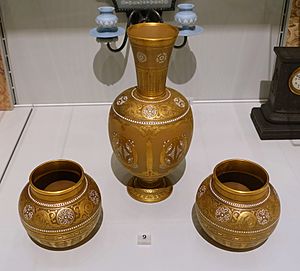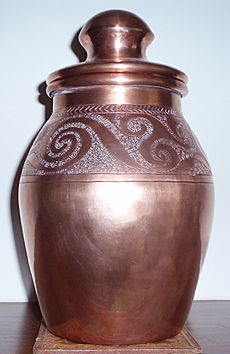Celtic Revival facts for kids
The Celtic Revival was a time when people became very interested again in Celtic culture. This happened mainly in the 1800s and 1900s. Artists and writers looked back at old stories and art from places like Ireland, Wales, and Scotland. They wanted to celebrate the unique traditions of these Celtic lands.

One of the most famous parts of this revival was the Irish Literary Revival. Irish writers like William Butler Yeats and Lady Gregory helped people appreciate traditional Irish stories and poems. This movement helped remind people of their rich history and culture.
The Celtic Revival was also a way for people to connect with the past during a time of big changes. It was especially important in Ireland, where people felt a strong link to their history. This interest helped create a strong sense of identity.
A lasting symbol of the Celtic Revival is the Celtic cross. These crosses, which look like ancient High crosses, are now common on monuments and gravestones around the world.
Contents
History of the Revival
People started studying the old cultures and histories of Britain and Ireland more closely in the late 1600s. Historians and experts began finding, translating, and publishing old manuscripts. They also recorded traditional stories, music, and languages.
In Wales, a writer named Iolo Morganwg started the Gorsedd. This group helped spark the Neo-druidism movement, which was interested in ancient Celtic spiritual practices.
Interest in Scottish Gaelic culture grew a lot in the late 1700s. This was thanks to works like James Macpherson's Ossian, which became famous worldwide. Novels by Sir Walter Scott and poems by Thomas Moore also helped.
Across Europe, the Romantic movement made people more interested in folklore, folk tales, and folk music. Even famous composers like Beethoven arranged Scottish folk songs. This growing interest in Celtic identity also tied into a rise in national pride, especially in Ireland.
The revival continued into the mid-1800s. People like Sir Samuel Ferguson helped make folk tales and histories popular in Celtic regions. At the same time, archaeologists and historians learned more about the past. People also became interested in 'Celtic' art designs. These designs, often seen in old Irish manuscripts, started appearing in architecture and other items. For example, Queen Victoria wore brooches that looked like ancient Celtic ones.
In Scotland, John Francis Campbell collected many traditional stories in his Popular Tales of the West Highlands. In the 1880s, groups like the Edinburgh Social Union helped bring back ancient myths and history into modern art. Important figures included Patrick Geddes, Robert Lorimer, and Douglas Strachan. Artists like Anna Traquair and John Duncan created beautiful works inspired by Celtic themes. Duncan's paintings, like Tristan and Iseult, are famous examples.
The Irish Literary Revival aimed to create art that felt truly Irish, different from English culture. This style helped build a stronger Irish identity, drawing on Irish history, myths, and folklore. Writers like Lady Gregory, WB Yeats, and John Millington Synge wrote plays and articles about Ireland. Places like the Abbey Theatre became important stages for new Irish writers.
The Celtic Revival was not just in Celtic countries. In America, the designer Thomas Augustus "Gus" O'Shaughnessy used Irish designs in his stained glass art. The architect Louis Sullivan also used Celtic-inspired patterns in his buildings. In England, the Watts Mortuary Chapel was decorated with beautiful Celtic designs.
The "plastic style" of early Celtic art also influenced the Art Nouveau movement. Designers like Archibald Knox used Celtic patterns in his metalwork for Liberty & Co.. These designs are still popular today, especially the interlace patterns, which are a national symbol in Ireland. This style has even appeared in modern tattoos and fantasy works. The animated film The Secret of Kells (2009) also features a lot of this ancient design.
In France, people like Jacques Cambry wrote about the beauty of Celtic landscapes. The Celtic Revival there was also linked to the idea that the French were "empire-building Celts." This led to the creation of the Académie Celtique in 1805.
Language and Culture Revivals (After 1920)
After 1920, efforts to revive Celtic languages and cultures continued.
In the Celtic Nations
Brittany
In 1925, Professor Roparz Hemon started the Breton-language magazine Gwalarn. It aimed to make Breton a major language and encouraged new literature. Later, Al Liamm continued this work.
Since 1977, Diwan schools have taught Breton using immersion. This means students learn all subjects in Breton. Popular comics like Asterix and The Adventures of Tintin have also been translated into Breton. There are also Breton TV shows and radio stations. Poets and singers like Alan Stivell have become known internationally.
Today, Breton is the only living Celtic language not officially recognized by its national government. However, efforts continue to promote it. The Ofis ar Brezhoneg (Office of the Breton language) encourages businesses and towns to use Breton. They also work with companies like Google and Microsoft to include Breton in their products. In 2014, Facebook added Breton as one of its languages.
Cornwall
The Cornish cultural revival in the early 1900s focused on the Cornish language. Henry Jenner and Robert Morton Nance led this effort. Groups like the Federation of Old Cornwall Societies (1924) and the Gorseth Kernow (1928) were formed to keep the "Celtic spirit of Cornwall" alive.
Ireland
Thanks to language revival efforts in schools, more young Irish people are speaking Irish today. It is even becoming more common to hear it in Irish cities. There is also a growing interest in learning Irish in North America.
Isle of Man
The Manx language has also seen revival efforts, with more people learning and speaking it.
Scotland
There are ongoing efforts to revitalize Scottish Gaelic, including in education and media.
Wales
The Welsh language has been spoken in Wales for a very long time. While its use declined in the 1900s, it did not disappear. By the early 2000s, the number of Welsh speakers began to increase again.
In 2004, about 21.7% of people in Wales spoke Welsh. While the 2011 census showed a slight drop, recent surveys suggest the number is rising again. Many schools in Wales now offer Welsh medium education, and Welsh is a required subject in English-speaking schools up to age 15-16.
Americas
Welsh in Argentina
Over 5,000 people speak Welsh in the Chubut province of Argentina. Some schools there now teach it.
Nova Scotia
Nova Scotia in Canada has the largest group of Scots Gaelic speakers outside of Scotland.
France
The ancient Gaulish language was once widely spoken in France. There have been attempts to revive and reconstruct it, even though we have limited information about its exact form. Some modern bands, like Eluveitie, even write songs in a revived form of Gaulish.
Auvergne
In the Auvergne region of France, people sing chants around bonfires to remember an ancient Celtic god. There are also modern efforts to revive the old Gaulish religion. Auvergne is important for the Gaulish revival because it has many ancient Gaulish sites and was home to the famous warrior Vercingetorix.
Elsewhere in Europe
The Celtic cultural revivals have also spread to Northern England. People are trying to reconstruct old types of bagpipes and are more interested in the Northumbrian smallpipes. There are also efforts to bring back the Cumbric language, an ancient Celtic language of Northern England.
Small areas of Celtic revival can also be found in Galicia (Spain).
See also
- Cuala Press
- Gaelic revival (Irish)
- Galician Institute for Celtic Studies
- Highland Revival
- Irish Literary Revival
- Modern Celts
- Scottish Gaelic Renaissance
- Scottish Renaissance
Images for kids
-
"Bollelin" series pewter plate designed by Archibald Knox, 1899






